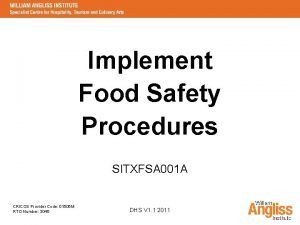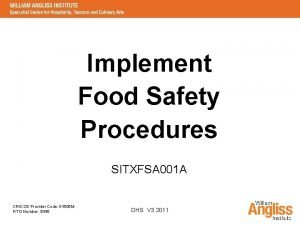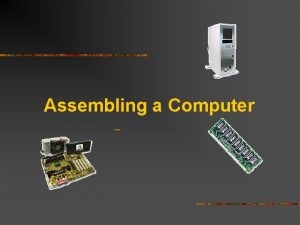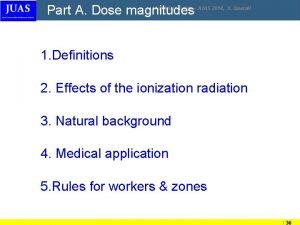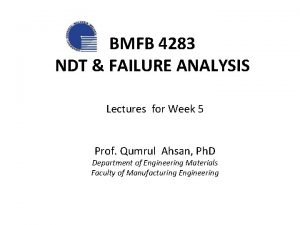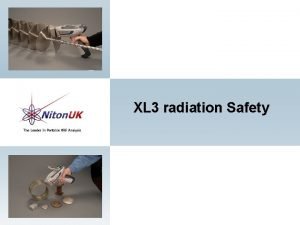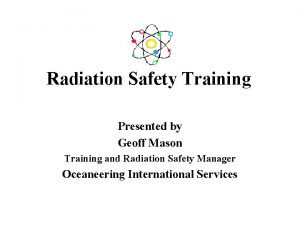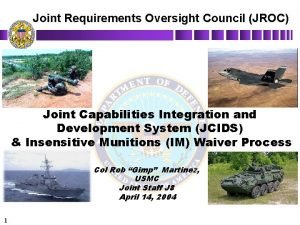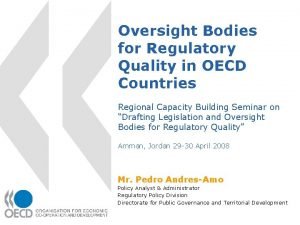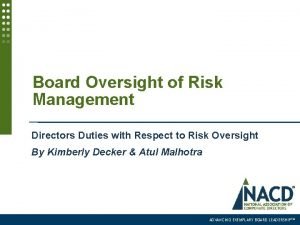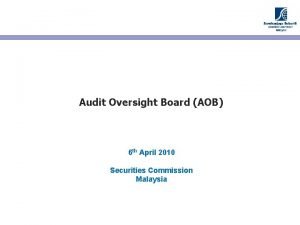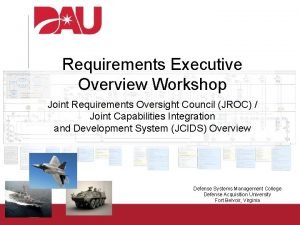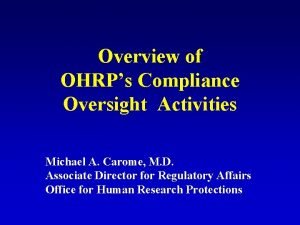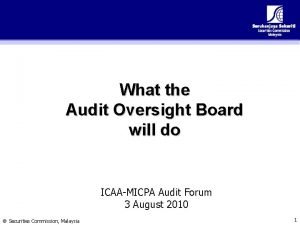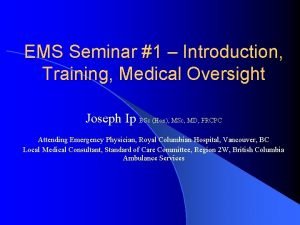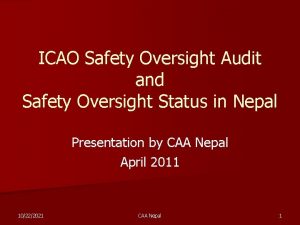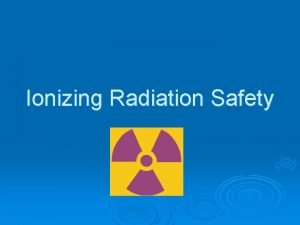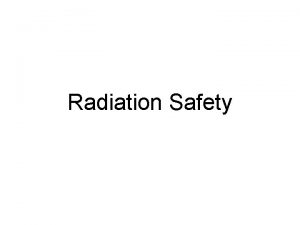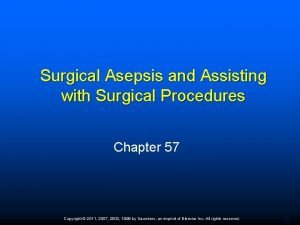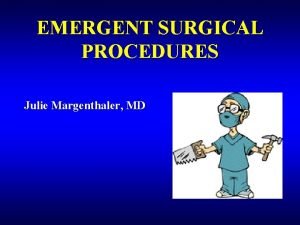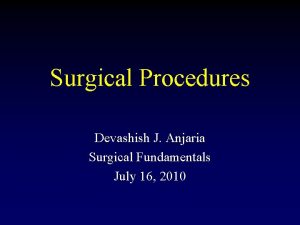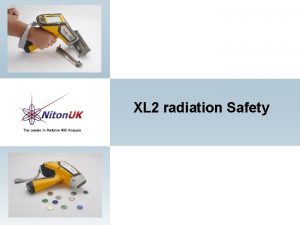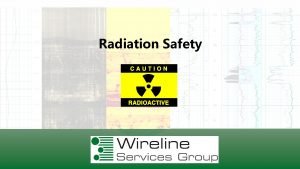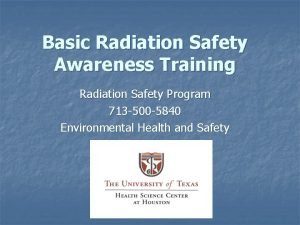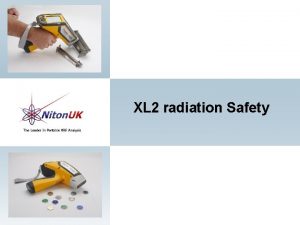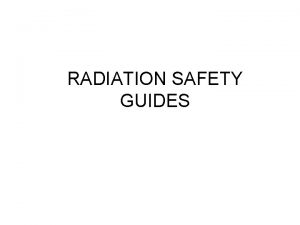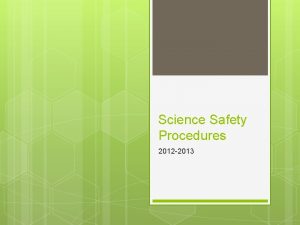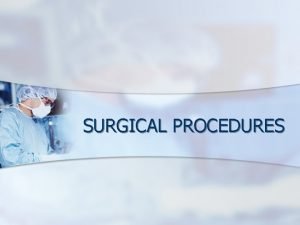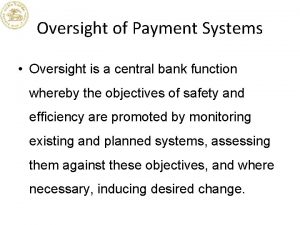Radiation Safety Oversight of Surgical Procedures Involving the




























- Slides: 28

Radiation Safety Oversight of Surgical Procedures Involving the Use of RAM René Michel, M. S. , RSO VA San Diego Healthcare System, San Diego, CA

Introduction v. The objective of this presentation is to review the various Radiation Safety aspects of a typical medical procedure that involves the use of radiological agents.

Introduction (Cont. ) v. Lymphoscintigraphy (LS) is a medical procedure for the treatment of malignant melanoma and mamma-carcinoma.

Introduction (Cont. ) v. The goal is to identify which sentinel lymph nodes (SLN) have been infiltrated by tumor cells

Introduction (Cont. ) v. The objective of this presentation is to determine what basic radiation safety controls are needed. v. ALARA, dosimetry, contamination control, radioactive waste, etc.

Outline v Radioactive Drugs Used v Overview of the Procedure v Radiation Exposure v Contamination Control v Recommendations

Radioactive Drugs v Many radiopharmaceuticals have been evaluated for and used in LS studies v The ideal drug, must have the following characteristics: 1) Small and uniform particle size 2) Short half-life 3) Low LET 4) Appropriate energy for gamma imaging

Radioactive Drugs v 198 Au colloid was one of the first widely used drugs in LS 198 Au Characteristics Particle size: 3 -5 nm Half-life: 2. 7 d Emissions: 412 ke. V photons plus beta particles

Radioactive Drugs v 198 Au was replaced by other agents with the increased availability of 99 m. Tc v Antimony trisulfide, albumin, human serum albumin, sulfur colloid and nanocolloid 99 m Tc Characteristics Particle size: 3 -90, 000 nm Half-life: 6 h Emissions: 140 ke. V photons

Procedure Overview v. There are three stages in Sentinel Node LS 1) Lymphatic Mapping 2) Intradermal Blue Dye Injection 3) SLN Biopsy

Lymphatic Mapping v. The surgeon injects about 1 m. Ci of 99 m. Tc unfiltered sulfur colloid intradermally near the lesion. v. The colloid is taken up by the lymphatic system and the patient is imaged with a conventional gamma camera. 2

Lymphatic Mapping (cont. ) v. About 20 min from injection dynamic scanning is performed v. A late phase scanning done 90 min after injection shows the location of the SLNs. v. The location of the node is marked on the skin of the patient 2

Blue Dye Injection v. The patient is moved to the OR to perform biopsy v. To assist in identifying the nodes draining the site of interest, a blue dye is injected 2

SLN Biopsy v. A surgeon uses the skin mark and a scintillation probe to relocalize the highest area of uptake

SLN Biopsy (cont. ) v. A dissection is performed through soft tissue to remove “hot” nodes located by the gamma probe v. All excised nodes are sent to the pathology lab for histological examination to asses for invasion by tumor cells

Radiation Exposure v. Nuclear Medicine personnel are excluded from this evaluation, they are already closely monitored. 2

Radiation Exposure (cont. ) v. Radiation exposure to OR and Pathology personnel and the potential for spread of contamination are considered the main radiation safety concerns. 2

Hazards Control-Radiation Exposure v. The expected radiation exposure to personnel from handling SLN radioactive specimens is very small v 10 -15 SLN procedures/year are performed in most large medical centers v. Several studies have documented dosimetry data

Hazards Control-Radiation Exposure (cont. ) Authors Surgeons OR Staff Pathologists (mrem) Waddington et al (2000) <2. 0 -- <3. 1 Tosi et al (2002) <1. 2 <0. 9 <1. 9 Kopp and Wengenmair (2002) <1. 6 <3. 2 <2. 2 Average whole-body radiation dose equivalent/procedure for hospital personnel from malignant melanoma and mamma-carcinoma SLN surgery with typical activities.

Hazards Control-Radiation Exposure (cont. ) v. A surgeon's hand dose has been reported to be ∽ 10 mrem (Miner et al. 1999) v. The pathologist’s hand dose is even smaller, ~ 4 -6 mrem (Veronesi et al. 1999)

Hazards Control- Contamination v. The residual activities a day post surgery are <0. 3 m. Ci for tumor-specimens and <50 n. Ci for SNLE (Kopp and Wengenmair 2002). v. These activities are relatively fixed to the tissue, they do not produce contamination that exceeds the allowed levels.

Hazards Control- Contamination v. Standard universal precautions used to prevent infections are sufficient to avoid any kind of incorporation in the bodies of those handling specimens.

Specimen Control v. Under 10 CFR 20. 1905 (NRC 2002), labeling is not required for containers holding less than 1. 0 m. Ci of Tc-99 m v. Labeling is also exempted if only authorized personnel have access to containers, provided a written record identifies the contents. v. Specimen quarantine before gross examination is unnecessary since the level of exposure to personnel is not a safety concern.

Specimen Control (cont. ) v. Despite the simplicity of the guidelines, each institution is expected to develop and implement procedures for handling radioactive specimens. v. Awareness training documentation for all individuals handling these specimens is also necessary.

Recommended Guidelines 1. Follow standard universal precautions (e. g. , wear hospital gown, surgical gloves, etc. ). 2. Using forceps, place all radioactive specimens removed from the patient in a sealed container. 3. In addition to the patient’s name and specimen number, label all resected primary site specimens with the name of the isotope (e. g. , 99 m. Tc), date and time when it was collected 4. Maintain security of specimens at all times

Recommended Guidelines 1. Upon completion of the surgical procedure, all instruments (e. g. , forceps, scalpels, etc. ) having had direct contact with the radioactive specimens should be cleaned following standard procedures. 2. All specimens should follow the normal biomedical waste stream and be surveyed before disposal to ensure that radiation levels are not distinguished from background

References 1. Miner T. et al. Guidelines for the Safe Use of RAM During Localization and Resection of the SLN. Ann Surg Oncol; 6: 75 -82 (1999) 2. Waddington W. et al. Radiation Safety of the Sentinel Lymph Node Technique in Breast Cancer. Europ J Nuc Med; 27: 377 -391 (2000) 3. Kopp, J. and Wengenmair, H. Radiation Protection in Intra- and Post. Operative Diagnosis of the SLN. 6 th European ALARA Network Workshop (2002) 4. Tosi, G. et al. Radiation Protection of the Workers in Radioguided Surgery of Breast Cancer. 6 th European ALARA Network Workshop (2002) 5. Veronesi U. et al. SLN Biopsy and Auxiliary Dissection in Breast Cancer. J Natl Cancer Inst; 91: 368 -73 (1999)

Questions/Comments?
 Sitxfsa001a
Sitxfsa001a Implement food safety procedures
Implement food safety procedures Chapter 10 workplace safety procedures
Chapter 10 workplace safety procedures Motherboard jumper settings diagram
Motherboard jumper settings diagram Background radiation
Background radiation Radiation safety
Radiation safety Radiation safety
Radiation safety Radiation safety
Radiation safety Delivery oversight
Delivery oversight Jcids instruction
Jcids instruction Regulatory oversight definition
Regulatory oversight definition Board of directors risk oversight responsibilities
Board of directors risk oversight responsibilities Ohrp is an oversight body
Ohrp is an oversight body Aob sanction
Aob sanction Low income oversight board
Low income oversight board Public procurement oversight advisory board
Public procurement oversight advisory board Management oversight and risk tree
Management oversight and risk tree Administrative oversight definition
Administrative oversight definition Joint requirements oversight council
Joint requirements oversight council Congress is most likely to exert oversight
Congress is most likely to exert oversight Ohrps
Ohrps What is audit oversight board
What is audit oversight board Risk based oversight
Risk based oversight Provincial medical oversight
Provincial medical oversight Dot
Dot Vẽ hình chiếu đứng bằng cạnh của vật thể
Vẽ hình chiếu đứng bằng cạnh của vật thể độ dài liên kết
độ dài liên kết Gấu đi như thế nào
Gấu đi như thế nào Các môn thể thao bắt đầu bằng tiếng chạy
Các môn thể thao bắt đầu bằng tiếng chạy
